Garuda’s Wing
Naomi Iizuka
Magic Theatre in a Co-Production with Campo Santo
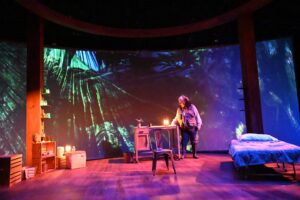
“I’m going to tell you a story, and then maybe you’ll remember.”
The last line of Naomi Iizuka’s latest play, Garuda’s Wing, is clearly aimed at us, the audience. The story we have witnessed over the past ninety minutes in Magic Theatre and Campo Santo’s world premiere production has been one involving past, present, and future. Dense scenes of jungle beauty – the kind one might attribute to the original Eden – are mystically, mysteriously surrounded by a sense of impending danger and of a foreboding future. The greed of capitalistic companies – be they forest-annihilating loggers, mega-pharmaceuticals looking for cancer cures, or so-called eco-friendly tours and lodges – is juxta-positioned with individuals who in their own ways are trying to fight off what more and more appears as the inevitable. And in amidst the jungle steam and symphonic sound of insects, ghosts roam to reveal their truths.
Is it too late in 2024? Can we hear this story and then remember to do the things to thwart future, eco-disaster? That is the important, powerful, and demanding question playwright Naomi Iizuka, director Margo Hall, and the stellar cast are asking us in this mesmerizing, haunting, and alarming world premiere of Garuda’s Wing.
The back-and-forth time travel of this magically intriguing and yet disturbing tale occurs on the island of Borneo, known locally by its Indonesian name of Kalimantan. This third-largest island in the world is home to one of the oldest, most extensive rain forests in the world (at least 140 million years old), 15,000 species of flowering plants, 3000 types of trees, and endangered species such as the Bornean orangutan.
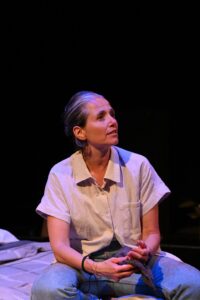
It is to the orangutans that primatologist Ellen Sewell (Nora el Samahy) is devoting her life while living in 1994 in the deep jungle alone. There, she daily spends time in mud up to her waist amongst leeches and ticks to try to get a glimpse and observe the illusive, solitary orangutan. To her jungle abode arrives Michael Suarez (Juan Amador) – a global-trotting, war-and-famine photojournalist who says he is here to “take pretty pictures” of the jungle’s butterflies, beetles, and of course, the orangutans.
But from the get-go, Ellen is skeptical of Michael’s true motive as she keeps asking with cynical edge, “Why?” She tells him how she hates not only the invading logging companies but even scientists who are “greedy to discover something new, patent it, and market it for mass consumption.” Even Michael’s desire to call the world’s attention through his photos to the orangutan’s threat of extinction is to Ellen totally wrong as she is sure people will then come to get that last glimpse. “They’ll flock here in droves and ruin it all … That’s what humans do.”

For Ellen, there is no gray, only black-and-white. After all, she has made some stark decisions to pursue her work with the orangutans. When Ellen made it clear she would never leave this jungle home, her biopharmaceutical executive husband, Karl, left Borneo four years earlier to return to their home in Atherton, California, taking their six-year-old daughter, Julia, with him. With a firm-jawed, not-going-to-budge-in-opinion look at the world, Ellen cynically and with some bitterness jabs Michael for naively believing exposure through compelling photographs of difficult situations can lead to awareness raising and to changes of heart. For action-oriented Ellen, pissing people/companies off and maybe even scaring them with her shotgun is her way of trying to protect the shrinking forest and habitat of her treasured orangutans.
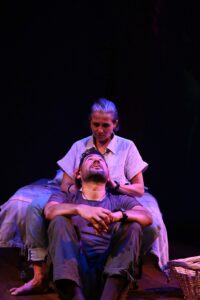
Nora el Samahy and Juan Amador are both compelling and fascinating as their characters debate opposing philosophies of life even as Ellen helps Michael survive his first couple of days in a place where dehydration, sepsis after a simple cut, or a tick left too long embedded can lead to death. In a scene where she is picking gently, tenderly through his unruly hair for the elusive ticks, she at same time bores with a vengeance into him about beliefs she sees as namby-pamby. Such a cleverly constructed scene is just one example of Margo Hall’s finely honed, wonderfully timed, and double-edged direction.
At one point, Michael mentions his botanist sister, Julia, who went missing during a scientific exploration a year before not far from where Ellen resides. Ellen notes, “You look like your sister,” setting up a mystery that continues to build in the following scenes taking place in 2014 and 2024, all in the same location.

In safari-type wear and knee-high boots, Michael’s sister, Julia, describes in 2014 her visit twenty years prior to Kalimantan. There, she came looking for a cure for her and Michael’s Alzheimer-stricken father among the forest’s many plants that were described in a manuscript by 19th-century naturalist Alfred Russell Wallace – lost documents that she discovered in Bali. Catherine Castellanos is arrestingly enthralling as her Julia recounts the research leading to her Borneo trip a year before her brother came to Ellen’s abode in 1994. Details revealed add more to the intrigue of her own unexplained disappearance.
The generational connections, secrets, and mysteries that are increasingly intertwined with the fate of Borneo’s primeval and under-threat rainforest further unfold in 2024. Ellen’s now-grown daughter, Diah (Kina Kantor), returns for the first time to the home where her mother lived until her death, ten years earlier. Where there was once a humble, jungle hut, now is a luxurious wellness retreat touting its eco-friendly blending with the surroundings.
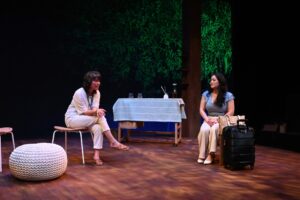
Diah is there to raise money among a special group of wealthy invitees for a foundation she runs to continue the jungle-saving work of the mother she barely ever knew. Greeted by the spa’s manager, Alice (Mia Tagano), the two women engage in small talk that at first seems innocent enough. However, hints begin to emerge of the real motive for Alice’s suggesting Diah come to the jungle. The ghosts of the past that roam seen and unseen among the thick forage once again enter the scene as connections are made between seemed strangers.
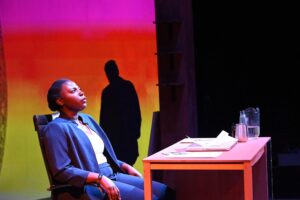
The final scene in 2058 is a visit by a ragged, jungle-traveled Stranger (Juan Amador) – maybe a ghost, maybe Michael, maybe both – into the sleek but stark, C-suite office of Grace Kibawa (Jeunée Simon), a Nigerian American now in Kalimantan working for a multi-national pharmaceutical company. In a stark setting vastly different from the lush, green world where Ellen once lived, the two interact in a conversation that is only vaguely connected to the earlier three scenes full of a family’s mystery. This final scene is the least satisfying of the four in a play that still seems like it is yet a few drafts away from its final form.
On a massive, curved, backdrop screen, the videos designed by Joan Osato provide lush, three-dimensional views of Borneo’s engulfing, steamy, beautiful but foreboding rainforest. Yet there is also conveyed a delicacy in the plants, a vulnerability of each stem and leaf that could so easily be lost forever.
In 2058, Grace is haunted by the belief that all is broken, that it is too late. The Stranger tells her about Garuda’s Wing, a plant with leaves that look like an ancient, Indonesian, part-man, part-bird god whose wings can stop the spinning of the earth. He tells her, “It can stop it just long enough to see the thing for what it is.”
In this first production of Naomi Iizuka’s Garuda’s Wing by Magic Theatre and Campo Santo, the question in 2024 is can we “see the thing for what it is,” for where our present course of inaction will lead us by mid-century? Hearing now the story, will we remember what needs to be done now?
Rating: 4 E
Garuda’s Wing continues in a world-premiere, ninety-minute (no intermission) production by Magic Theatre and Campo Santo at the Magic Theatre, Fort Mason Center for the Arts & Culture, 2 Marina Boulevard, Landmark Building D, 3rdFloor, San Francisco. Tickets are available at https://magictheatre.org or by contacting boxoffice@magictheatre.org (415-441-8822).
Photos by Jay Yamada

Leave a Reply